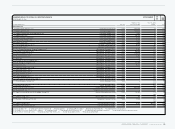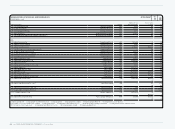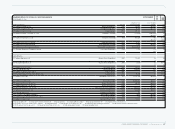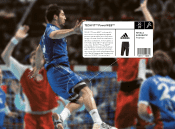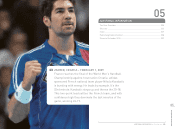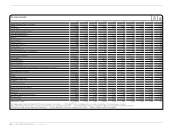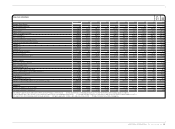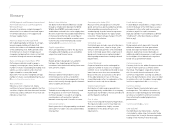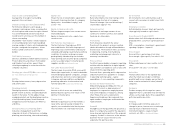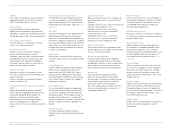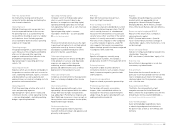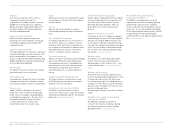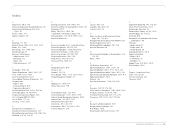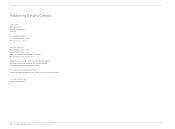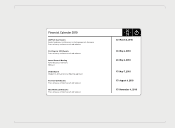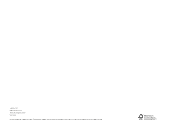Reebok 2009 Annual Report Download - page 229
Download and view the complete annual report
Please find page 229 of the 2009 Reebok annual report below. You can navigate through the pages in the report by either clicking on the pages listed below, or by using the keyword search tool below to find specific information within the annual report.
ADDITIONAL INFORMATION Glossary 225
ÖKO-Tex Standard 100
An international testing and certification
system for textiles, defining and limiting the
use of certain chemicals.
Operating lease
Method of leasing assets over periods less
than the expected lifetime of those assets.
An operating lease is accounted for by the
lessee without showing an asset or a liability
on his balance sheet. Periodic payments
are accounted for by the lessee as operating
expenses for the period.
Operating margin
Group operating profit as a percentage of net
sales. Measure of the company’s profitability
after cost of sales and other operating
expenses and income. Best indicator of the
profitability of operating activities.
Operating margin = (operating profit / net
sales) × 100.
Operating overheads
Expenses which are not directly attributable to
the products or services sold such as costs for
sales, marketing overheads, logistics, research
and development, as well as general and
administrative costs, but not including costs for
promotion and communications.
Operating profit
Profit from operating activities after cost of
sales and operating expenses.
Operating profit = gross profit + royalty and
commission income + other operating income
– sales working budget – marketing working
budget – operating overheads.
Operating working capital
Company’s short-term disposable capital
which is used to finance its day-to-day
business. In comparison to working capital,
operating working capital does not include
non-operational items such as cash, financial
assets and taxes.
Operating working capital = accounts
receivable + inventories – accounts payable
see also Working capital.
Option
Financial instrument which ensures the right
to purchase (call option) or to sell (put option)
a particular asset (e.g. shares or foreign
exchange) at a predetermined price (strike
price) on or before a specific date.
Other operating expenses
Expenses which are not directly attributable
to the products or services sold. Operating
expenses are expenses for sales and
marketing, research and development,
general and administrative costs as well as
depreciation of non-production assets.
Other operating income
Comprises all income from normal operations
that is not already included in other income
items.
Own-retail activities
Sales directly generated through a store
operated by a brand segment within the adidas
Group. Own retail includes Concept Stores
(e.g. adidas Sport Performance, Originals and
Sport Style) and concession corners as well as
factory outlets and e-commerce for the adidas,
Reebok and Rockport brands.
Performance business
In the sporting goods industry, business
related to technical footwear and apparel, used
primarily in doing sports.
PGA Tour
Major US men’s professional golf tour,
featuring 49 golf tournaments.
Price-earnings ratio (P/E)
A company’s share price divided by its current
or future diluted earnings per share. The P/E
ratio is used by investors as a fundamental
measure of the attractiveness of a particular
security versus other securities or the overall
market. It is usually more useful to compare
P/E ratios of one company to other companies
in a similar industry. In general, a high P/E
ratio suggests that investors are expecting
higher earnings growth in the future compared
to companies with a lower P/E.
Price points
Specific selling prices, normally using
“psychological” numbers, for example a
product price of US $ 99.99 instead of US $ 100.
Private placement
Placement of debt securities directly to
institutional investors, such as banks, mutual
funds, insurance companies, pension funds
and foundations.
Promotional expenditure
Expenses related to promotion partnerships
Promotion partnerships
Partnerships with events, associations,
leagues, clubs and individual athletes. In
exchange for the services of promoting the
adidas Group, the party is provided with cash
and/or promotional material.
Regions
The adidas Group distinguishes seventeen
markets which are aggregated into six
geographies: Western Europe, European
Emerging Markets, North America, Greater
China, Other Asian Markets and Latin America.
Return on capital employed (ROCE)
Measure of the returns that a company is
realising from its capital.
ROCE = (income before taxes + financial
result + extraordinary income) / (average of
shareholders’ equity + minority interests + total
net borrowings).
Return on equity (ROE)
Indicator of company profitability related to the
shareholders’ financing.
ROE = net income / shareholders’ equity × 100.
Risk-free rate
Rate of return to be expected on a risk-less
investment, e.g. federal bonds.
Risk premium
Extra return that the overall market or a
particular stock must provide over the risk-free
rate to compensate an investor for taking a
relatively higher risk. Risk premium = market
risk – risk-free rate.
Royal and Ancient (R&A)
The R&A is the ruling authority of golf
everywhere except the United States and
Mexico, where this responsibility rests with the
United States Golf Association (USGA) see
also United States Golf Association (USGA).
Sales working budget
Sales working budget expenditures relate
to advertising and promotion initiatives at
the point of sale as well as store fittings and
furniture.


